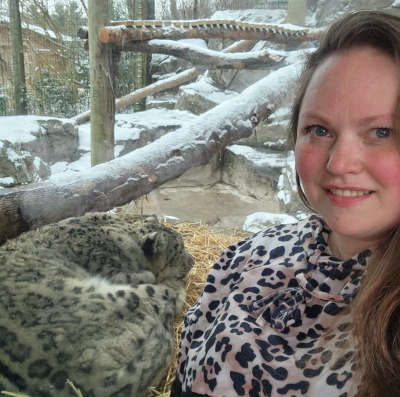For uncomplicated cat pregnancies, most of the work and monitoring are done at home, not in the veterinary hospital. That makes it important that you recognize what’s normal and abnormal for a cat pregnancy. With that in mind, here is what your feline friend’s pregnancy should look like week by week so that you know when things are going as planned and when you need your vet to intervene.
How long does cat pregnancy last?
The average duration of a cat’s pregnancy (also referred to as the gestation period) is about 63 to 65 days. This is just over 2 months; approximately 9 weeks total. Just as with humans, the length of pregnancy can vary between individuals. In cats, it can be as short as 58 days, or as long as 72 days. Factors such as the individual cat’s breed, health condition, and environmental factors can influence the length of the pregnancy. Monitoring the signs and seeking veterinary guidance throughout the pregnancy will help ensure the well-being of the mother cat and her kittens.
If you happen to know the date of breeding, you’ll be able to determine the approximate birth date. However, if you don’t know the breeding date, speak to your vet and read on to help determine your cat’s stage of pregnancy.
Signs of a pregnant cat

Most cats won’t start ‘showing’ until she’s over halfway through her pregnancy. So, unless you get a veterinary confirmation, you’ll have to rely on other signs to know if your cat is pregnat. Some of those early signs that may indicate a pregnancy include:
- No more heat cycles
- Behavior changes, mainly becoming or affectionate and sleeping more
- Some vomiting
- Decrease in appetite
- Enlarged, pink nipples
Later on you may notice:
- An increase in appetite
- Nesting behavior and possibly aggression toward other pets
- Weight gain
- Enlarged abdomen
- Enlarged vulva
Let’s further explore those signs of pregnancy and discuss what pregnancy looks like week by week for a cat.
What pregnancy looks like on cats (with pictures)
As your cat’s pregnancy progresses, you’ll notice some subtle or distinct changes occurring week by week.
Week 1-2
This stage often goes unnoticed; if anything, you may see subtle behavioral changes such as increased affection, decrease in appetite, or mild restlessness. https://www.shutterstock.com/image-photo/domestic-life-pet-cat-welcome-his-1017066844
Week 3
You may see physical alterations like slight weight gain and enlarged nipples.
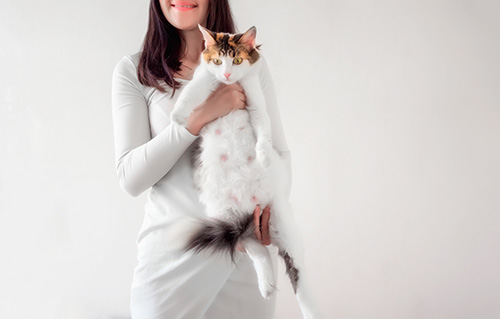
Week 4
Your cat’s abdomen might start to become enlarged, modestly and you may start to notice an increased appetite.
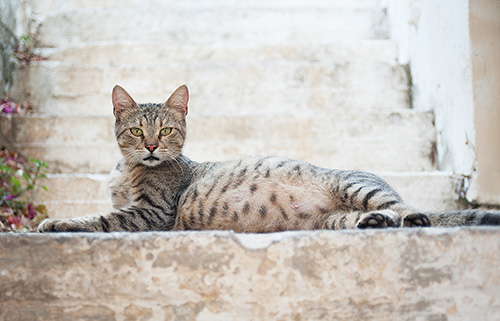
Week 5-6
Abdomen enlargement is more noticeable, and you may actually feel the growing fetuses when gently feeling her belly (don’t squeeze!)
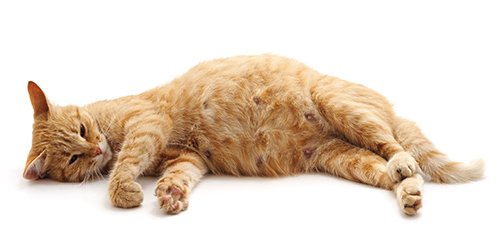
Week 7
Her appetite increases significantly as the developing kittens place greater nutritional demands on her body.
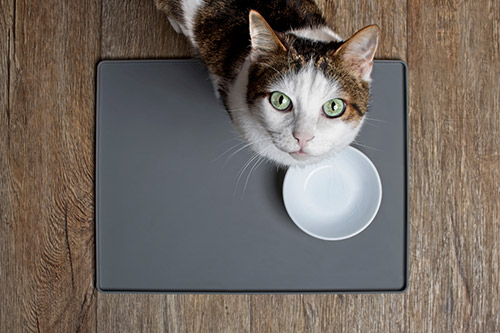
Week 8
The pregnancy is evident both visually and through physical movement of fetuses.
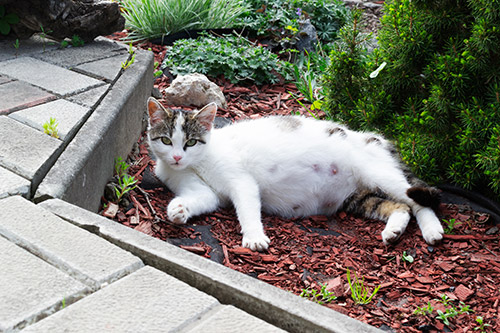
Week 9
Prepare for birth! At this point cats begin to display nesting, decreased appetite, restlessness, increased affection or seeking solitude, vulvar swelling or discharge, and a drop in body temperature.

Remember, each cat is unique, and these timelines may vary. Regular veterinary check-ups are vital to monitor the progression of your cat’s pregnancy and ensure the health and well-being of both the mother and her kittens.
What are the visual characteristics of pregnancy in cats?
While the earliest signs of pregnancy may be incredibly subtle, as the weeks progress, you’ll notice distinct physical changes.
The first visible sign of pregnancy in cats is often enlarged nipples that turn more pink than the surrounding skin. This happens at about three weeks gestation.
The nest visible signs is an enlarged abdomen. This usually becomes noticable around five weeks gestation and continues to grow until she gives birth.
An enlarged vulva and vulvar discharge may be present in the later stages of pregnancy. Remember, even if you’re seeing signs like this, it is of vital importance to consult with your veterinarian to confirm. There are some medical conditions that may mimic these signs, and these conditions can be serious.
Dos and Don’ts while your cat is pregnant
To ensure the health and well-being of your pregnant cat, here are some essential do’s and don’ts to consider:
Do #1: Provide a nutritious diet: Feed your cat a high-quality, balanced diet specifically formulated for pregnant or nursing cats. There are some diets specifically formulated for this life stage, otherwise a kitten food is recommended. Consult your veterinarian for recommended dietary adjustments.
Do #2: Offer a comfortable and quiet nesting area: Create a cozy and secluded space where your cat can relax and give birth comfortably. Provide soft bedding materials like blankets for her to create a nest.
Do #3: Monitor her closely: Observe your cat regularly for any unusual behavior, changes in appetite, or signs of distress. Contact your veterinarian if you notice any concerning symptoms.
Do #4: Ensure regular veterinary check-ups: Regular visits to the veterinarian are crucial during pregnancy. Your vet can monitor the progress, provide necessary vaccinations, and offer guidance throughout the entire pregnancy journey.
Don’t #1: Don’t administer any medications without veterinary approval: Avoid giving any medications to your cat without consulting your veterinarian first. Some medications may be harmful to the developing kittens.
Don’t #2: Don’t allow access to harmful substances: Keep your cat away from toxic plants, chemicals, and hazardous substances that could pose a risk to her and her unborn kittens.
Don’t #3: Don’t allow access to dangerous situations: If your cat is normally allowed to go outside, do your best to keep her indoors so she’s at reduced risk for injury or illness that could cause complications for her health or the health of her future litter.
Don’t #4: Don’t stress or handle her excessively: Minimize stress and unnecessary handling during the later stages of pregnancy. Allow your cat to rest and limit physical interactions to avoid potential complications. Make sure she has privacy, don’t allow strange visitors or animals to disturb her, and help children and adults in the household understand that they should leave the cat alone for a while.
Frequently Asked Questions
Can a cat get pregnant while she is nursing?
Yes, it is possible for a cat to become pregnant while she is nursing. It’s important to take appropriate measures as having repeated litters so close together is not ideal for her health. The best prevention while a cat is nursing is to keep her isolated from any male cats that are not neutered.
How can I prepare for my cat’s delivery?
Provide a quiet and comfortable nesting area. A bedding area with soft blankets make a good nesting box and can be placed in a private room. Don’t isolate the cat here, just give her the option to go to it (but keep her indoors). It can be helpful to have some assistive supplies ready. This includes clean towels, a thermometer to check temperature if the cat tolerates it (and a plain lubricant), even cotton balls. Also, familiarize yourself with the signs of labor.
How old does a cat have to be before she can get pregnant?
It is possible for cats to reach sexual maturity (and be impregnated) as early as 4 months of age. It’s crucial to have them spayed as early as your veterinarian will allow it, if they are not part of a quality breeding program.
How many litters can a cat have every year?
Worst case scenario, a cat can end up having three to four litters in a year. Responsible breeding programs typically limit them to one or two litters annually to ensure the health and well-being of the mother cat.
Is it safe or beneficial for my cat to have kittens?
A cat doesn’t have to have a litter of kittens before she is spayed. It doesn’t do anything to better her health or wellbeing. Deciding whether to let your cat have kittens should be done responsibly and in consultation with a veterinarian. Responsible breeding practices and ensuring suitable homes for the kittens are crucial for their well-being. It’s important to consider the inherent risks associated with allowing a cat to remain intact and the potential complications that can arise during pregnancy, such as dystocia. Additionally, it’s worth noting that there are no formally documented benefits for the mother cat to become pregnant, especially repeatedly.
What is the best way to prevent pregnancy in a cat?
The best way to prevent pregnancy in a cat is to have her spayed. Spaying is a surgical procedure performed by a veterinarian that removes the reproductive organs, preventing future pregnancies. Keeping your cat confined isn’t an effective option as cats in heat get very determined and will try (and often succeed!) to break out of confinement to find a male cat.
What health conditions can look like pregnancy in a cat?
Certain health conditions can cause signs that mimic the pregnancy signs outlined above. These can included hormonal imbalances, pseudopregnancy (false pregnancy), organ failure that leads to ascites (fluid accumulation in the abdomen related to heart disease, kidney disease, liver disease, FIP, or cancer.) Whether you believe your cat is pregnant or not, if you notice enlargement of your cat’s abdomen, consult with a veterinarian is necessary to determine the underlying cause.


